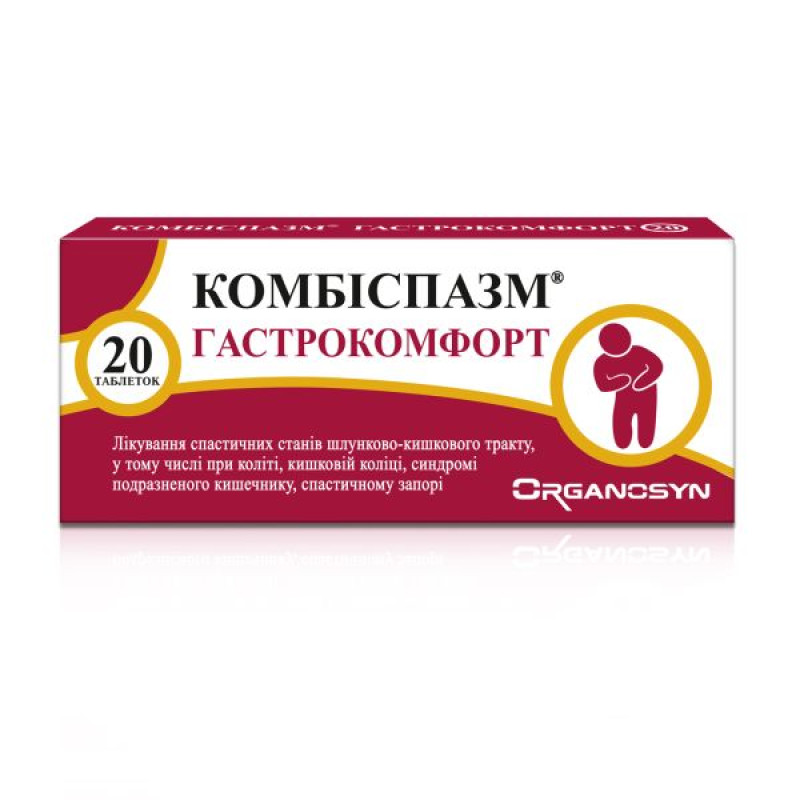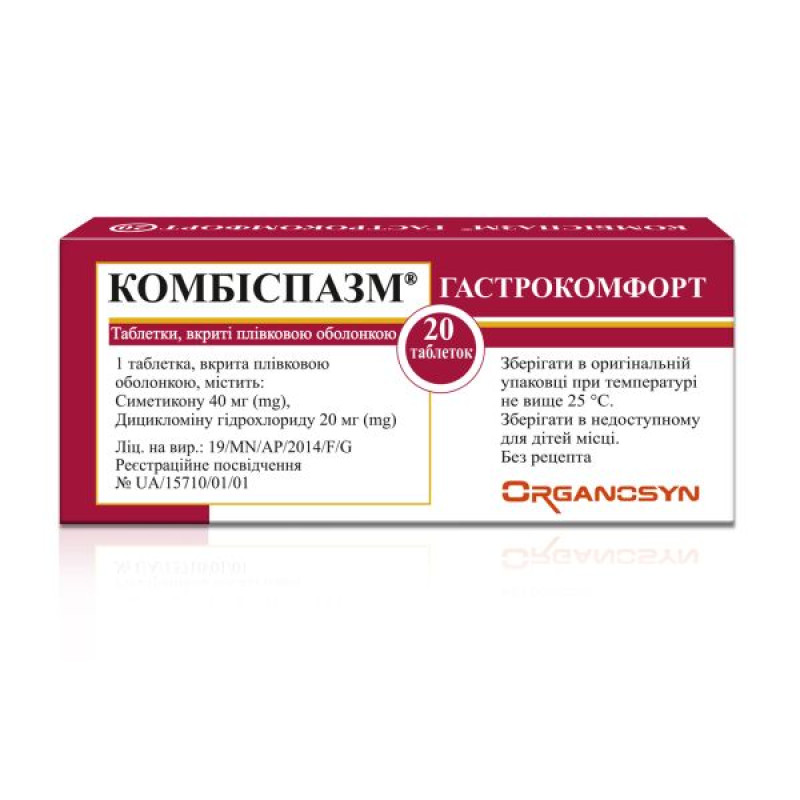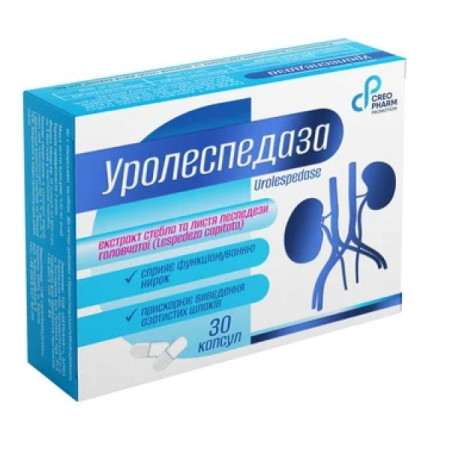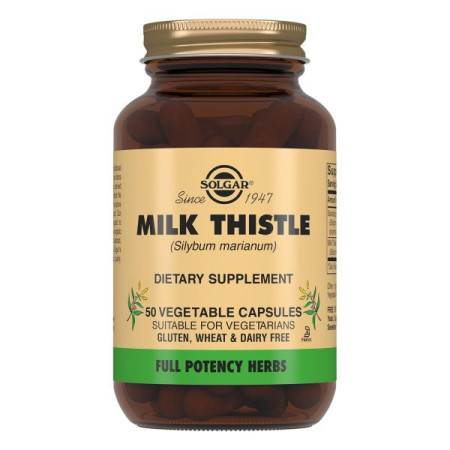Combispasm Gastrocomfort film-coated tablets blister No. 20

Instructions for use Combispasm Gastrocomfort film-coated tablets blister pack No. 20
Composition
active ingredients: simethicone, dicyclomine hydrochloride;
1 film-coated tablet contains simethicone 40 mg, dicyclomine hydrochloride 20 mg;
Excipients: corn starch, microcrystalline cellulose, povidone, light magnesium carbonate, magnesium stearate, talc, colloidal anhydrous silicon dioxide, sodium starch glycolate, croscarmellose sodium, hypromellose, polyethylene glycol 6000, titanium dioxide (E 171).
Dosage form
Film-coated tablets.
Main physicochemical properties: white, round, biconvex, film-coated tablets.
Pharmacotherapeutic group
Antispasmodics and anticholinergics in combination with other drugs. Antispasmodics in combination with other drugs. ATX code A03E D.
Pharmacological properties
Pharmacodynamics
Dicyclomine hydrochloride has an antispasmodic effect (relieves spasm of smooth muscles in the gastrointestinal tract, abdominal pain associated with this spasm or with stretching of the gastrointestinal tract wall) and an antisecretory effect on the excretory glands. The action of dicyclomine consists in a specific anticholinergic (antimuscarinic) effect on acetylcholine receptors, as well as a direct antispasmodic effect on smooth muscles.
Simethicone is a surfactant, defoamer. The mechanism of action is based on reducing the surface tension of gas bubbles, which contributes to the free removal of gases from the gastrointestinal tract or their absorption by the intestinal wall. Simethicone improves the quality of radiographs and sonograms, provides better distribution of contrast agents on the intestinal mucosa.
Pharmacokinetics
Dicyclomine hydrochloride is rapidly absorbed from the gastrointestinal tract after oral administration, with peak plasma concentrations occurring within 60–90 minutes; excreted mainly in the urine (79.5% of the administered dose), and partially in the feces (8.4%). The mean elimination half-life is 1.8 hours. The mean volume of distribution is 3.65 l/kg.
Simethicone is a physiologically and chemically inert substance; it is not absorbed and is excreted unchanged after passing through the digestive tract.
Indication
- Treatment of conditions accompanied by spasm of smooth muscles of the gastrointestinal tract and flatulence, as well as associated abdominal pain.
- Treatment of spastic conditions of the gastrointestinal tract, including colitis, intestinal colic, irritable bowel syndrome, and spastic constipation.
- In the complex treatment of organic diseases of the gastrointestinal tract in colitis, diverticulitis, enteritis, gastritis, peptic ulcers.
Contraindication
Hypersensitivity to the active substances or to other components of the drug, intestinal obstruction, obstructive diseases of the urinary tract, prostate adenoma with difficulty urinating, renal failure, obstructive diseases of the gastrointestinal tract, severe ulcerative colitis or toxic megacolon, reflux esophagitis, unstable cardiovascular system with acute bleeding, glaucoma, myasthenia gravis, thyrotoxicosis, heart failure.
Interaction with other medicinal products and other types of interactions
Amantadine, class I antiarrhythmic drugs (e.g. quinidine), antihistamines, antipsychotics (e.g. phenothiazines), benzodiazepines, MAO inhibitors, narcotic analgesics (e.g. meperidine), nitrates and nitrites, sympathomimetics, tricyclic antidepressants and other drugs with anticholinergic activity may enhance the effects or side effects of dicyclomine.
Anticholinergic agents, including dicyclomine, may neutralize the effect of antiglaucoma agents, so the drug should be prescribed with caution in cases of increased intraocular pressure and concomitant use of corticosteroids.
Anticholinergics, including dicyclomine, may alter the gastrointestinal absorption of some drugs, particularly long-acting digoxin, which may lead to increased plasma digoxin concentrations.
Dicyclomine may neutralize the effects of drugs that alter gastrointestinal motility, such as metoclopramide.
Since antacids may reduce the absorption of anticholinergics, including dicyclomine, their concomitant use should be avoided.
The inhibitory effect of anticholinergic agents, including dicyclomine, on gastric hydrochloric acid secretion may neutralize drugs used to treat achlorhydria and study gastric secretion.
The absorption of levothyroxine in the intestine may be impaired when taken simultaneously with simethicone.
Application features
The drug should be used with caution in patients with autonomic neuropathy, liver or kidney disease, ulcerative colitis (taking high doses can cause paralytic ileus and the development or exacerbation of such a serious complication as toxic megacolon), arterial hypertension, ischemic heart disease, congestive heart failure, tachyarrhythmias, hiatal hernia and prostatic hypertrophy.
At high ambient temperatures during treatment with the drug, overheating of the body is possible (increased body temperature and heat stroke due to decreased sweating). If relevant symptoms appear, discontinue use of the drug and consult a doctor.
Diarrhea may be an early symptom of incomplete intestinal obstruction, especially in patients with an ileostomy or colostomy. In such cases, treatment with the drug is inadequate and may be harmful.
In individuals with individual hypersensitivity to anticholinergics, the drug may cause central nervous system effects such as confusion, disorientation, ataxia, increased fatigue, or vice versa - euphoria, excitement, insomnia, affective state. These symptoms usually disappear within 12–24 hours after discontinuation of the drug.
Use during pregnancy or breastfeeding
The safety of the drug for use in pregnant women has not been established, so it should not be used during pregnancy.
Since dicyclomine hydrochloride passes into breast milk, the drug is contraindicated during breastfeeding.
Ability to influence reaction speed when driving vehicles or other mechanisms
Dicyclomine hydrochloride may cause drowsiness and blurred vision. Do not drive or operate machinery while taking this medicine.
Method of administration and doses
Adults and children over 12 years of age: the drug is used 1 tablet up to 4 times a day before or after meals. The maximum daily dose is 4 tablets. The duration of treatment is up to 5 days.
Children
The drug is used in children from 12 years of age.
Overdose
Symptoms: headache, nausea, vomiting, dry mouth, difficulty swallowing, blurred vision, dilated pupils, hot and dry skin, dizziness, tachycardia, change in respiratory rate, psychomotor agitation. Possible curare-like effect (neuromuscular blockade, feeling of weakness in muscles and paralysis).
Treatment: symptomatic, in the first hours it is recommended to induce vomiting and wash the stomach.
Adverse reactions
On the part of the digestive system: dry mouth, loss of taste, anorexia, nausea, vomiting, indigestion, feeling of bloating, abdominal pain, constipation.
Central nervous system: tinnitus, headache, drowsiness, weakness, nervousness, psychosis, numbness, dizziness, coma, confusion and/or agitation (especially in elderly patients), dyskinesia, insomnia, disorientation, short-term memory loss, hallucinations, dysarthria, ataxia, euphoria, inadequate emotional reactions (symptoms decrease 12-24 hours after dose reduction).
On the part of the organs of vision: blurred vision, double vision, pupil dilation, accommodation paralysis, increased intraocular pressure (short-term atropine-like effects that disappear after discontinuation of dicyclomine).
Skin/allergic reactions: hypersensitivity reactions, including allergic dermatitis, pruritus, rash, urticaria, erythema, drug idiosyncrasy, angioedema, anaphylactic shock.
From the genitourinary system: difficulty urinating, urinary retention.
Cardiovascular system: tachycardia, feeling of increased heartbeat.
From the respiratory system: shortness of breath, apnea, nasal congestion.
Other effects: decreased sweating, nasal congestion, sneezing, swelling of the throat mucosa, suppression of lactation.
Expiration date
3 years.
Storage conditions
Store in original packaging at a temperature not exceeding 25 ° C. Keep out of the reach of children.
Packaging
10 film-coated tablets in a blister of aluminum film and aluminum foil; 1 or 2 blisters in a cardboard pack.
Vacation category
Without a prescription.
Producer
Evertogen Life Sciences Limited.
Location of the manufacturer and its business address
Plot No. S-8, S-9, S-13 and S-14, A.P.I.C, S.I.Z Pharma, Green Industrial Park, Polepally (BI), Yedcherla (EM), Mahabubnagar, IN - 509 301, India/
Plot No. S-8, S-9, S-13 & S-14, APIIC, Pharma Sez, Green Industrial Park, Polepally (V), Jadcherla (M), Mahabubnagar, In-509 301, India.
There are no reviews for this product.
There are no reviews for this product, be the first to leave your review.
No questions about this product, be the first and ask your question.















